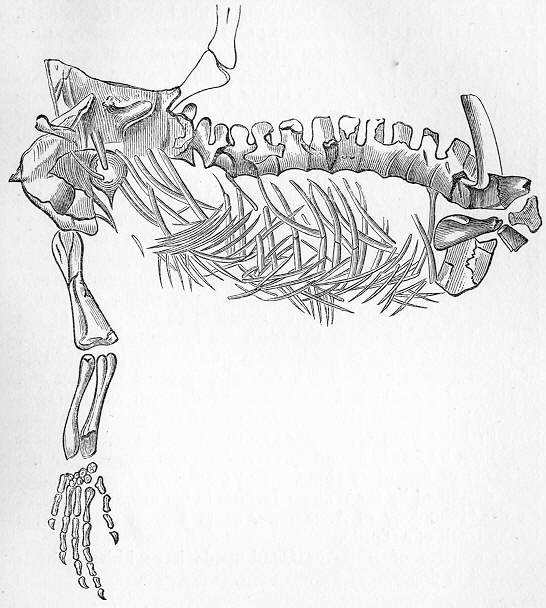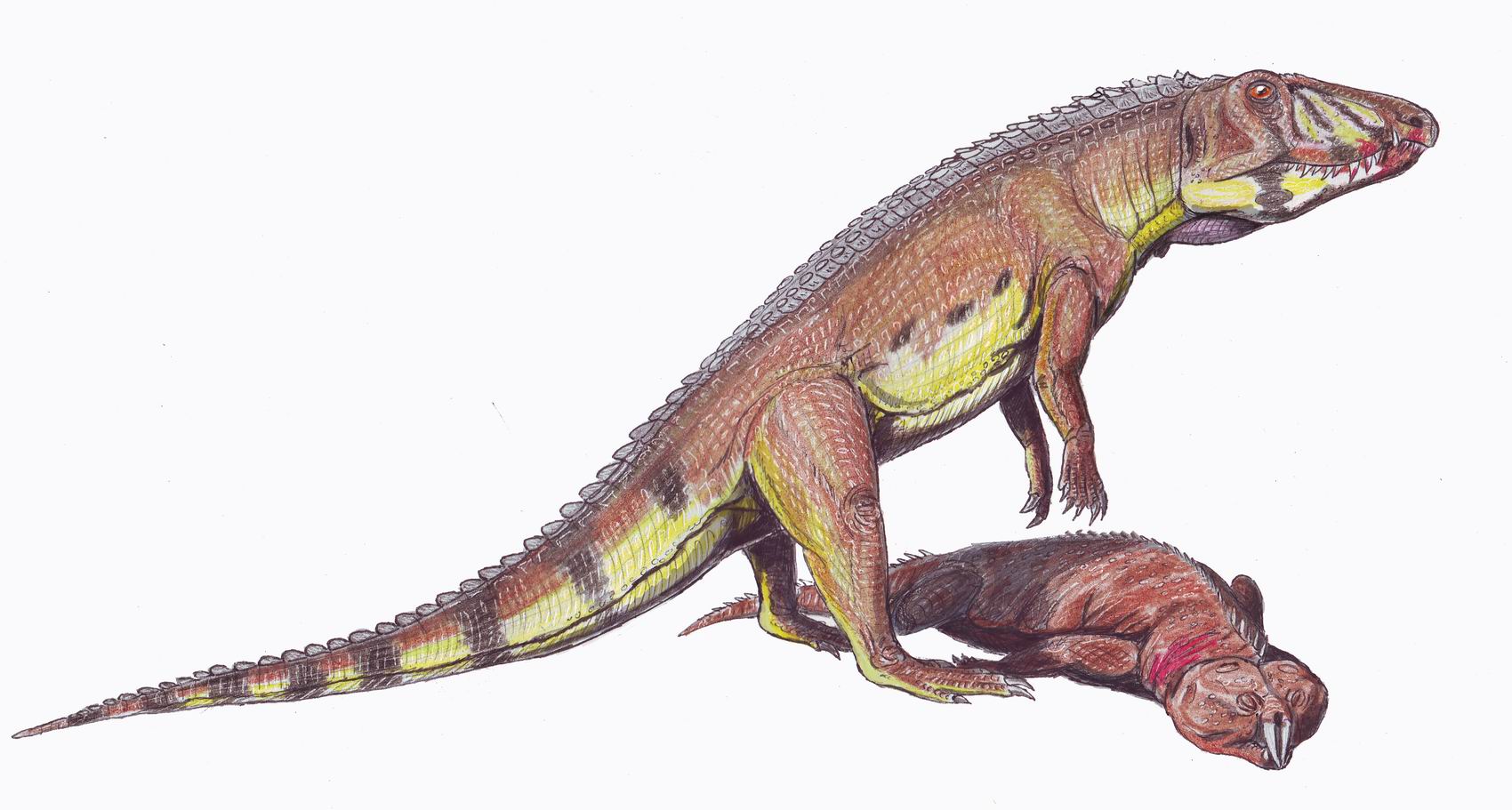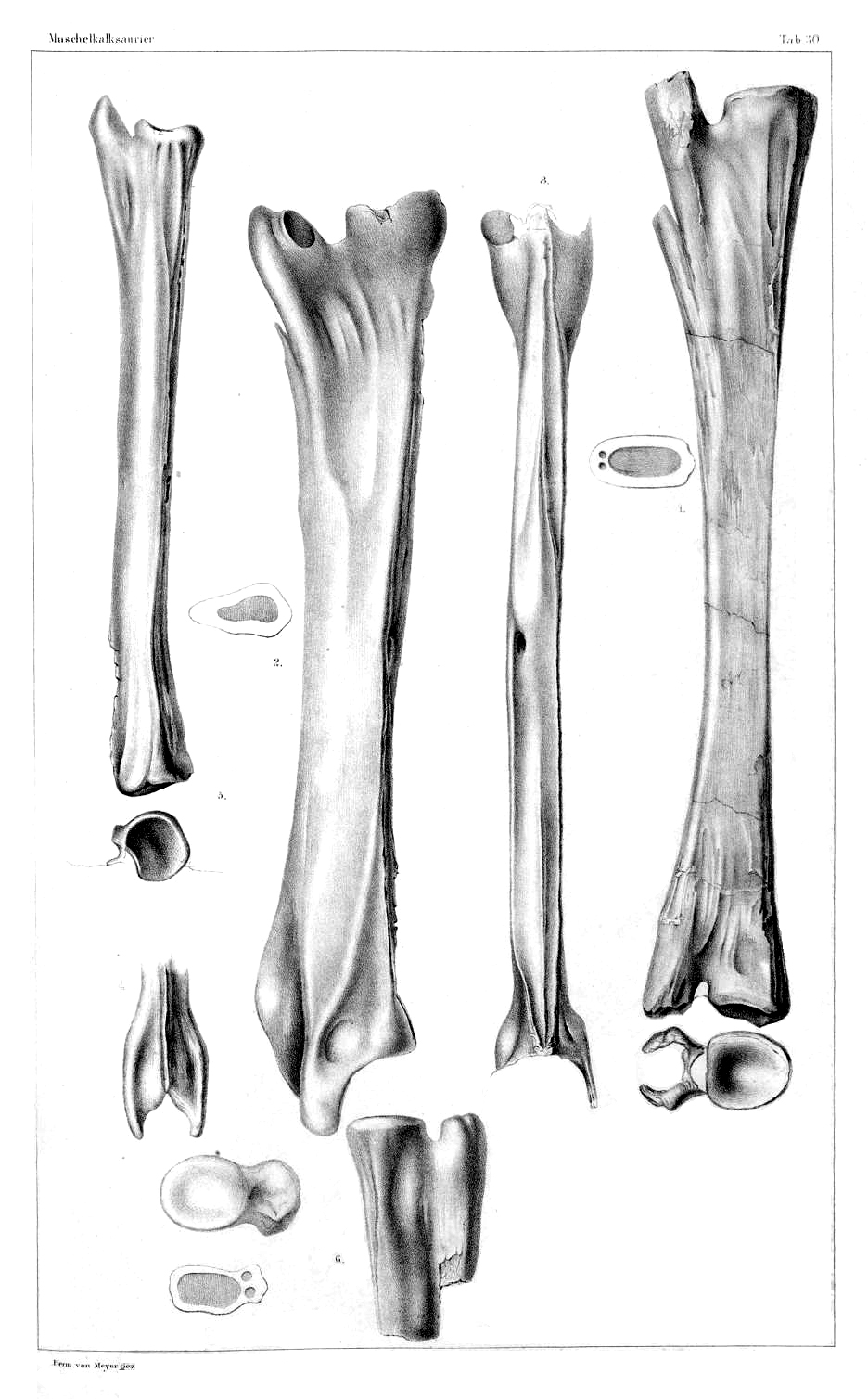|
Tanysauria
Tanysauria (meaning "long lizards") is an extinct clade long-necked archosauromorph reptiles from the Triassic period of Europe, Asia, North America, and South America. It comprises the families Tanystropheidae and Trachelosauridae (found by the authors to be coextensive with Dinocephalosauridae, and a senior synonym of the latter). Within the Archosauromorpha, Tanysauria represents the sister group to the Crocopoda. It contains many of the species formerly placed in "Protorosauria", which is now thought to be a paraphyletic group. Definition The clade Tanysauria was described by Stephan Spiekman and co-authors in 2024. Its name comes from the Greek τᾰνυ 'tany''meaning "long" and σαῦρος 'sauros''meaning "lizard," which refers to the long necks and, in some cases, bodies of tanysaurians. According to the phylogenetic definition given by Spiekman et al., the clade Tanysauria includes all taxa that are more closely related to ''Tanystropheus longobardicus'', '' Din ... [...More Info...] [...Related Items...] OR: [Wikipedia] [Google] [Baidu] |
Protorosauria
Protorosauria is an extinct, likely paraphyletic group of basal archosauromorph reptiles from the latest Middle Permian ( Capitanian stage) to the end of the Late Triassic ( Rhaetian stage) of Asia, Europe and North America. It was named by the English anatomist and paleontologist Thomas Henry Huxley in 1871 as an order, originally to solely contain '' Protorosaurus''. Other names which were once considered equivalent to Protorosauria include Prolacertiformes and Prolacertilia. Protorosaurs are distinguished by their long necks formed by elongated cervical vertebrae, which have ribs that extend backward to the vertebrae behind them. Protorosaurs also have a gap between the quadrate bones and the jugal bones in the back of the skull near the jaw joint, making their skulls resemble those of lizards. While previously thought to be monophyletic, the group is now thought to consist of various groups of basal archosauromorph reptiles that lie outside Crocopoda, though some re ... [...More Info...] [...Related Items...] OR: [Wikipedia] [Google] [Baidu] |
Protorosaurus Speneri
''Protorosaurus'' (from , 'earlier' and , 'lizard') is an extinct genus of reptile. Members of the genus lived during the late Permian period in what is now Germany and Great Britain. Once believed to have been an ancestor to lizards, ''Protorosaurus'' is now known to be one of the oldest and most primitive members of Archosauromorpha, the group that would eventually lead to archosaurs such as crocodilians and dinosaurs. Description ''Protorosaurus'' grew up to in length, and was a slender, lizard-like animal, vaguely resembling a monitor lizard, with long legs and a long neck. History ''Protorosaurus'' was one of the first fossil reptiles to be described, being initially described in Latin in 1710 by from a specimen found in Thuringia in Germany, who considered the animal to be a crocodile, and most similar to the Nile crocodile (''C. niloticus''). Over a century later, in publications in 1830 and 1832 Christian Erich Hermann von Meyer, Hermann von Meyer recognised ''Pr ... [...More Info...] [...Related Items...] OR: [Wikipedia] [Google] [Baidu] |
Trachelosauridae
Trachelosauridae (also known as Dinocephalosauridae) is an extinct clade of archosauromorph reptiles that lived throughout the Triassic period. Like their close relatives the tanystropheids, they were " protorosaur"-grade archosauromorphs characterized by their long necks. Unlike tanystropheids, which lengthen their neck primarily by elongating the individual cervical (neck) vertebrae, trachelosaurids achieved their long necks by the addition of more vertebrae. The most extreme example of this trend was '' Dinocephalosaurus'', which had at least 32 vertebrae in the neck alone, far more than the 13 neck vertebrae of ''Tanystropheus''. Trachelosaurids are known from Europe (Poland, Germany, Austria, Netherlands) and China. Some members of the family (i.e. ''Dinocephalosaurus'') were solely marine animals with paddle-like limbs, inhabiting the coastlines of the Tethys Ocean. ''Dinocephalosaurus'' was so specialized for aquatic life that it evolved to be viviparous (live-bearing), th ... [...More Info...] [...Related Items...] OR: [Wikipedia] [Google] [Baidu] |
Protorosaurus
''Protorosaurus'' (from , 'earlier' and , 'lizard') is an extinct genus of reptile. Members of the genus lived during the late Permian period in what is now Germany and Great Britain. Once believed to have been an ancestor to lizards, ''Protorosaurus'' is now known to be one of the oldest and most primitive members of Archosauromorpha, the group that would eventually lead to archosaurs such as crocodilians and dinosaurs. Description ''Protorosaurus'' grew up to in length, and was a slender, lizard-like animal, vaguely resembling a monitor lizard, with long legs and a long neck. History ''Protorosaurus'' was one of the first fossil reptiles to be described, being initially described in Latin in 1710 by from a specimen found in Thuringia in Germany, who considered the animal to be a crocodile, and most similar to the Nile crocodile (''C. niloticus''). Over a century later, in publications in 1830 and 1832 Christian Erich Hermann von Meyer, Hermann von Meyer recognised ''Pr ... [...More Info...] [...Related Items...] OR: [Wikipedia] [Google] [Baidu] |
Dinocephalosauridae
Trachelosauridae (also known as Dinocephalosauridae) is an extinct clade of archosauromorph reptiles that lived throughout the Triassic period. Like their close relatives the tanystropheids, they were "Protorosauria, protorosaur"-Evolutionary grade, grade archosauromorphs characterized by their long necks. Unlike tanystropheids, which lengthen their neck primarily by elongating the individual cervical vertebrae, cervical (neck) vertebrae, trachelosaurids achieved their long necks by the addition of more vertebrae. The most extreme example of this trend was ''Dinocephalosaurus'', which had at least 32 vertebrae in the neck alone, far more than the 13 neck vertebrae of ''Tanystropheus''. Trachelosaurids are known from Europe (Poland, Germany, Austria, Netherlands) and China. Some members of the family (i.e. ''Dinocephalosaurus'') were solely marine animals with paddle-like limbs, inhabiting the coastlines of the Tethys Ocean. ''Dinocephalosaurus'' was so specialized for aquatic life ... [...More Info...] [...Related Items...] OR: [Wikipedia] [Google] [Baidu] |
Tanystropheidae
Tanystropheidae is an extinct family (biology), family of archosauromorph reptiles that lived throughout the Triassic Period, often considered to be "protorosaurs". They are characterized by their long, stiff necks formed from elongated cervical vertebrae with very long cervical ribs. Members of the group include both terrestrial and aquatic forms. While some tanystropheids were small lizard-like animals, other tanystropheids such as ''Tanystropheus'' were large animals that had necks that were several meters long, longer than the rest of their bodies. Tanystropheids are known from Europe, Asia (Russia, China, and Saudi Arabia), North America and probably South America (Brazil). The presence of tanystropheids in Europe and China indicate that they lived along much of the coastline of the Tethys Ocean. However, species in western North America are found in terrestrial deposits, suggesting that as a group, tanystropheids were ecologically diverse. Relationships among tanystropheid ... [...More Info...] [...Related Items...] OR: [Wikipedia] [Google] [Baidu] |
2024 In Reptile Paleontology
This list of fossil reptiles described in 2024 is a list of new taxa of fossil reptiles that were binomial nomenclature, described during the year 2024, as well as other significant discoveries and events related to reptile paleontology that occurred in 2024. Squamates Squamate research * A study on the biogeography of squamates throughout their evolutionary history, providing evidence of a localized Pangaean origin (Africa, Australia, Eurasia and Sundaland, Sunda) of the squamate crown group in the Jurassic followed by strong regionalization to Eurasia for subsequent Jurassic lineages, is published by Wilenzik, Barger & Pyron (2024). * New lizard assemblage, including fossil material of a pleurodontan iguanian, a Teiioidea, teiioid and a possible Scincoidea, scincoid, is described from the Upper Cretaceous (Campanian-Maastrichtian) Allen Formation (Argentina) by Garberoglio ''et al.'' (2024). * Revision of the fossil material of Paleocene lizards from the Walbeck fissure fillin ... [...More Info...] [...Related Items...] OR: [Wikipedia] [Google] [Baidu] |
Archosauromorph
Archosauromorpha (Greek for "ruling lizard forms") is a clade of diapsid reptiles containing all reptiles more closely related to archosaurs (such as crocodilians and dinosaurs, including birds) than to lepidosaurs (such as tuataras, lizards, and snakes). Archosauromorphs first appeared during the late Middle Permian or Late Permian, though they became much more common and diverse during the Triassic period. Although Archosauromorpha was first named in 1946, its membership did not become well-established until the 1980s. Currently Archosauromorpha encompasses four main groups of reptiles: the stocky, herbivorous allokotosaurs and rhynchosaurs, the hugely diverse Archosauriformes, and a polyphyletic grouping of various long-necked reptiles including '' Protorosaurus'', tanystropheids, and '' Prolacerta''. Other groups including pantestudines (turtles and their extinct relatives) and the semiaquatic choristoderes have also been placed in Archosauromorpha by some authors. Ar ... [...More Info...] [...Related Items...] OR: [Wikipedia] [Google] [Baidu] |
Crocopoda
Archosauromorpha (Greek for "ruling lizard forms") is a clade of diapsid reptiles containing all reptiles more closely related to archosaurs (such as crocodilians and dinosaurs, including birds) than to lepidosaurs (such as tuataras, lizards, and snakes). Archosauromorphs first appeared during the late Middle Permian or Late Permian, though they became much more common and diverse during the Triassic period. Although Archosauromorpha was first named in 1946, its membership did not become well-established until the 1980s. Currently Archosauromorpha encompasses four main groups of reptiles: the stocky, herbivorous allokotosaurs and rhynchosaurs, the hugely diverse Archosauriformes, and a polyphyletic grouping of various long-necked reptiles including ''Protorosaurus'', tanystropheids, and '' Prolacerta''. Other groups including pantestudines (turtles and their extinct relatives) and the semiaquatic choristoderes have also been placed in Archosauromorpha by some authors. Archosauro ... [...More Info...] [...Related Items...] OR: [Wikipedia] [Google] [Baidu] |
Tanystropheus
''Tanystropheus'' (~ 'long' + 'hinged') is an extinct genus of archosauromorph reptile which lived during the Triassic period, Triassic Period in Europe, Asia, and North America. It is recognisable by its extremely elongated neck, longer than the torso and tail combined. The neck was composed of 13 vertebrae strengthened by extensive cervical ribs. ''Tanystropheus'' is one of the most well-described non-Archosauriformes, archosauriform archosauromorphs, known from numerous fossils, including nearly complete skeletons. Some species within the genus may have reached a total length of , making ''Tanystropheus'' the longest non-archosauriform archosauromorph as well. ''Tanystropheus'' is the namesake of the family Tanystropheidae, a clade collecting many long-necked Triassic archosauromorphs previously described as "Protorosauria, protorosaurs" or "Prolacertiformes, prolacertiforms". ''Tanystropheus'' contains at least two valid species as well as fossils which cannot be referred to ... [...More Info...] [...Related Items...] OR: [Wikipedia] [Google] [Baidu] |
Trachelosaurus
''Trachelosaurus'' is an extinct genus of lizard-like early archosauromorph reptiles in the family Trachelosauridae. It was originally described as a dinosaur until it was redescribed as a "Protorosauria, protorosaur" reptile by Robert L. Carroll in 1988. The type species, ''T. fischeri'', was described by F. Broili & E. Fischer in 1917F. Broili and E. Fischer. (1917). ''Trachelosaurus fischeri'' nov. gen. nov. sp. A new dinosaur from the Buntsandstein of Bernburg. ''Jahrbuch der Königlich Preussischen geologischen Landesanstalt zu Berlin'' 37(1):359-414 based on remains found in the Solling Formation (Buntsandstein), Bernburg, Germany.H. H. Ecke. (1986). Palynologie des Zechsteins und Unteren Buntsandsteins im Germanischen Becken. ''Dissertation Georg-August-Universität Göttingen'' 1-117 A 2024 redescription identified ''Trachelosaurus'' as a long-necked and presumably aquatic reptile closely related to ''Dinocephalosaurus'' from the Guanling Formation of China. Classificatio ... [...More Info...] [...Related Items...] OR: [Wikipedia] [Google] [Baidu] |





